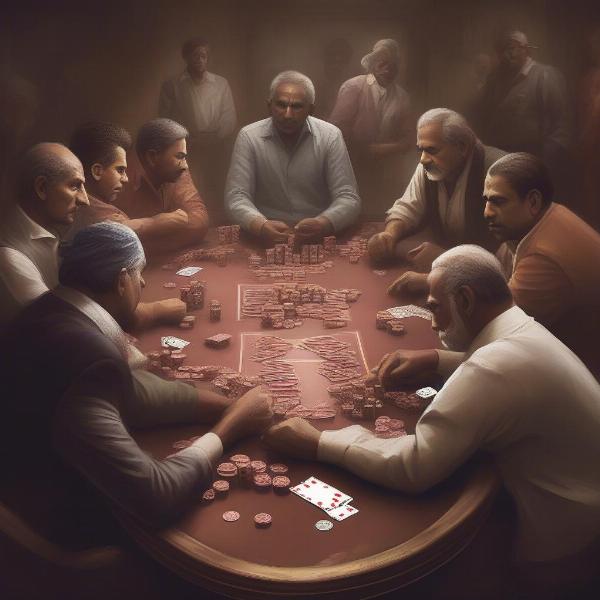Indian Poker, also known as Blind Man’s Bluff, is a simple yet engaging card game perfect for casual gatherings. The game relies on bluffing and reading your opponents, as you can only see everyone else’s cards, not your own. Here’s how to master the art of deception and become an Indian Poker pro.
Understanding the Basics of Indian Poker
Indian Poker differs from traditional poker in a key aspect: players hold their cards on their foreheads, facing outwards, visible to everyone except themselves. This creates a unique dynamic where you must deduce the value of your own card by observing the bets and reactions of other players. The game requires a keen sense of observation, strategic betting, and a healthy dose of risk-taking.
Getting Started: What You’ll Need
To play Indian Poker, you’ll need a standard deck of 52 cards. The number of players can range from two to ten, but the game is generally more exciting with more participants. You’ll also need something to bet with – this could be poker chips, coins, or even candy.
Gameplay: Step-by-Step Guide
- Dealing the Cards: Shuffle the deck thoroughly and deal one card face down to each player. Players pick up their card without looking at it and place it on their forehead, facing outwards.
- Initial Bets: Before any cards are revealed, each player places an initial bet, known as the “ante,” into the pot.
- The Betting Rounds: Starting with the player to the dealer’s left, each player has two options: bet or fold. A bet adds more to the pot, while folding means withdrawing from the current round and forfeiting any money already bet. The betting continues clockwise, with each player having the opportunity to raise the bet, call (match the current bet), or fold.
- Revealing the Cards: Once all bets are placed, the remaining players reveal their cards. The player with the highest card wins the pot. In case of a tie, the pot is split between the tied players.
Mastering the Art of Bluffing in Indian Poker
Bluffing is a crucial element of Indian Poker. Since you can’t see your own card, you can sometimes convince others that you have a strong hand even if you don’t. A well-timed bluff can force players with higher cards to fold, allowing you to win the pot with a weaker hand.
Tips for Effective Bluffing
- Observe Your Opponents: Pay close attention to their betting patterns and reactions. Are they hesitant or confident?
- Control Your Expressions: Maintain a poker face, regardless of your card. Avoid giving away tells through facial expressions or body language.
- Vary Your Bets: Don’t always bet high when you have a good hand. Mixing up your betting patterns will make you less predictable.
 Indian Poker Bluffing Strategies
Indian Poker Bluffing Strategies
Advanced Strategies for Indian Poker
While the basic rules are simple, Indian Poker offers plenty of room for strategic play. Here are a few advanced tips to elevate your game:
- Consider the Range of Cards: Think about the possible cards you might have based on the reactions of others.
- Pay Attention to Betting Patterns: Identify aggressive players and those who tend to fold easily. Adjust your strategy accordingly.
- Manage Your Bankroll: Set a budget and stick to it. Avoid chasing losses and know when to walk away.
Expert Insights
“In Indian Poker, information is your most valuable asset. Use every clue, every reaction, to build a picture of the game,” says renowned poker strategist, Dr. Anya Sharma.
“Don’t be afraid to bluff, but do it strategically. A well-placed bluff can win you the pot even against a stronger hand,” adds professional poker player, Michael Johnson.
 Advanced Indian Poker Strategies
Advanced Indian Poker Strategies
Variations of Indian Poker
Several variations of Indian Poker exist, adding exciting twists to the gameplay. These include:
- Blind Man’s Bluff with Swaps: Players have the option to swap cards with another player for a small fee.
- Indian Poker with Jokers: Adding jokers to the deck introduces an element of unpredictability.
- Progressive Indian Poker: The ante increases with each round, raising the stakes.
Conclusion
Indian Poker is a thrilling card game that combines luck, bluffing, and strategic thinking. By following these tips and practicing your skills, you can increase your chances of winning and enjoy hours of fun. So gather your friends, grab a deck of cards, and get ready to experience the excitement of Indian Poker!
FAQ
- Can I look at my own card in Indian Poker? No, the core of the game revolves around not knowing your own card.
- What is the highest card in Indian Poker? An Ace is the highest card.
- What happens if two players have the same card? The pot is split evenly between the tied players.
- Can I bet more than once in a round? You can raise the bet if another player has already bet, but you only get one initial bet.
- Is Indian Poker the same as Texas Hold’em? No, they are different games. Indian Poker doesn’t involve community cards.
- How many players can play Indian Poker? Ideally, 2-10 players.
- What is the best strategy for Indian Poker? Observing your opponents, strategic bluffing, and managing your bankroll are key strategies.

